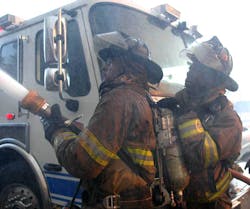Armpit Firefighters & Hose Stream Management
Have you ever seen an armpit firefighter? You know the type, the firefighter who has the nozzle tucked into their armpit while trying to rotate it around to put the fire out. As today's firefighters are not gaining the same amount of nozzle times as our past generations, drilling has never been more important. While teaching groups of young and older firefighters, it has been revealed that the armpit firefighters are out there and until identified, they will continue to pull their boots on and respond, pits ready.
A debate that has been around since my first day in the jumpseat is: pistol grip or no pistol grip? Many firefighters feel like putting a handle on a nozzle is a invitation to stick it in the armpits and teach firefighters "lazy" nozzle handling. Let's take a look at the armpit firefighters and how you can make sure your not fighting from the pits!
From the back roads of rural America to the downtown streets in the urban environment, firefighters ride on engines with the purpose of putting the fires out. Engines by far outnumber every other type of apparatus in the fires service. Since we all have at least one engine how should engine training rank in your department? First? The basis for all engine work should be hose advancement and nozzle handling. Learning proper nozzle positions is a skill that should be taught from day one and never left out as we progress through the years.
A common problem is that firefighters keep the nozzle to close to their shoulders. By not using a short section of hose between your armpit and nozzle limits your ability to move the nozzle. If you need to sweep, raise, or lower the nozzle you will need the hose to be long enough to make the moves. So how much hose is enough? That is a personal preference with a minimum being a length that will allow the firefighter to operate the ball of the nozzle. Each firefighter should experiment with the length to make it manageable and safe, while still keeping control of the flow.
It has always been this jumpseat rider's opinion that the hardest working member of a hose team is the backup firefighter. This is more true in the example of the armpit firefighters. Often they are fighting from their pits because the hose is either too short or the backup firefighter isn't taking the pressure off of them. Coordinating the backup role with the nozzle role is a skill that can be often overlooked when drilling. Many times, in no visibility environments, the firefighters will need to just "know" how to move to coordinate the nozzle operation.
If you are assigned the backup firefighter's role, you need to make sure the nozzle firefighter has enough hose to operate. So, how do you know? Developing crew awareness comes from working together in training and developing standard operating procedures at the department level. How often have you seen well-trained firefighters working in perfect unison without a word being said?
Another cause of the armpit warriors is the over pressuring of the hoselines. Determine the proper pumping pressures and pay close attention to the needs each time you purchase new hose, nozzles, and engines. As technology gets better, friction loss and pump pressures will change. If you don't adjust for these changes the hose could have so much pressure that the nozzle firefighter will not have an option other than to stick it in their pits to control it.
Having breakaway or combination nozzles will also make for a challenging armpit firefighter. If you choose to breakaway your nozzle or use it as a smooth bore style the pump operator needs to be told. I have seen many firefighters break a nozzle down and not tell the pump operator, causing the hose to be pumped at fog nozzle pressures with a smooth bore at the tip. Make sure that you make the announcement each time you change the nozzle or nozzle setting.
Stopping the armpit firefighter problem should start immediately! No matter what type of nozzle your department uses all firefighters should be well schooled in the art of firefighting. Using a nozzle should be a base for firefighter training. During the training is where we develop good nozzle, backup, and advancement skills that are needed to be an effective "team." If you are a armpit firefighter it's time to make the announcement and reach out for help! Ask your fellow firefighters for help bringing you out of the pits!
Have a great Memorial Day Weekend.
Bunker up, buckle in, it's where we all begin!
- See Ryan Live! Blogger Ryan Pennington will be presenting "Hoarder Homes: Piles of Hazards for Firefighters" at Firehouse Expo in Baltimore, July 23 - 27.
